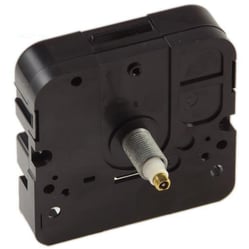Quartz Clock Movements
Quartz Clock Movements Open up Your Vistas

Quartz clock movements are the contemporary digital matching of conventional, mechanical nerve center for timekeeping. Yet quartz clock movements (also referred to as clock motors) have no springtimes, weights, pulleys, or gears to track time; rather, the quartz crystal generates a stream of pulses that are extremely quick and very steady, indicating that counting and partitioning the pulses gives a precise procedure of elapsed time. Let us see just how these wonderful tools can open up a new world to you.
Non-quartz clock movements operate mechanically, utilizing rotational pressure to transform a flywheel and a series of gears to figure out individual time units (i.e., secs). Without law, the flywheel would spin also fast, which is where pendulums and escapement mechanisms been available in. The pendulum is restricted to swing one extent in half a second, and the equipment network translates the oscillation right into seconds, minute, and hours.
Modern electronic motors work identically-- at the very least to the viewer-- although a completely various method is used to get the exact same results. The first thing one requires to comprehend is that quartz crystals naturally vibrate at their reverberating frequencies when a voltage decrease is put on them. Next off, one must recognize that the whole factor of clocks is to track elapsed time (resetting every 12 or 24-hour), and that whether this is done mechanically or online is a non-issue.
Nonetheless, the digital approach has many advantages that surpass simply eliminating the mass of flywheels, weights, and gears. Electronic motors basically digitize the entire procedure, converting what utilized to be done in hardware into software. This provides a lot better flexibility and flexibility than their mechanical counterparts, and as a matter of fact they can execute essentially whatever functionality can be thought up since shows has no hardware restraints.
For instance, suppose we wish to extend the resetting time, or the period at which everything twists around to where it started? Twelve hours and twenty-four hours are popular options, but there's absolutely nothing avoiding one from going a full week, or perhaps a month!
Certainly, there's no factor applying such time extensions if you couldn't show them, meaning specifically calibrated dials and potentially an added hand. For the weekly period, the days are printed in the center of the dial and the (brief) added hand jumps to the following day every 24 hours. Likewise, for once-a-month periods, days of the month are published along the dial's circumference and a lengthy hand ticks to the following once a day.
A neat option "clock" activity that you can get keeps an eye on tide degree. The only actual difference is going from a solar cycle to the lunar cycle, which is 1 day and 50 mins. The motion needs to be initialized and calibrated for regional conditions, but once this is done the tide degree will always be accurate.
The tide-level motion (which can be incorporated with average timekeeping to present time and trend on one face), is a type of lead-in to movements that depart from periodicity. Right here, things revealed is a climate phenomenon, such as moisture or temperature, and the solitary hand rotates in between 2 extremes of a scale. Sensing units are made use of to discover present worths, and the electric motor converts the value right into hand position.
The astute reader will certainly recognize that we are no longer in the realm of quartz movements, as there is no factor to track elapsed time. However the digital quartz technology has actually maximized the creativity to think in terms of software application instead of hardware.
An interesting by-product of all this is that there is a market for clocks and attributes of the past, such as grandpa clocks with oscillating pendulums. The electronic movements can suit such needs via simulation, despite the fact that pendulums are no longer working parts; this is especially useful for clockmakers who desire to bring back an old, non-functioning antique. Obviously, chiming clock movements open your vistas.